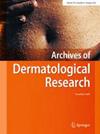Claudin-1 expression in acne and its correlation with disease severity: clinical and in silico validation
Abstract
The pilosebaceous unit is the site of a common chronic inflammatory skin disorder called acne. Tight junctions (TJ) are present in sebocytes and are primarily composed of claudin-1. When claudin-1 is knocked down, the TJ barrier leaks, and holocrine secretion is compromised. This leads to the accumulation of partially degenerated sebocytes in the pilosebaceous ducts and the creation of microcomedos, which can cause acne lesions. The study’s aim was to measure the claudin-1 gene and protein expression in acne patients’ blood samples and establish a correlation with the severity of the condition and their levels. 48 acne patients were involved and 48 matched control for age and sex. First samples were obtained from both groups and RNA was extracted from the whole blood sample followed by qPCR to measure the relative expression of the claudin-1 gene. Enzyme-linked immunosorbent assay (ELISA) was used to measure claudin-1 protein level. There were statistically significant lower relative expression of claudin-1 gene (p = 0.001) and its protein level (p = 0.001) in acne patients compared to controls (0.34 ± 0.32 vs 1.0 ± 0.0, 0.64 ± 0.62 vs 3.85 ± 2.14, respectively). There was a statistically significant inverse correlation between claudin-1 protein expression and acne severity (R = −0.374, p = 0.009). Computational and bioinformatics tools were used for enrichment analysis to better understand claudin-1 role in the context of the disease and provide possible therapeutic approaches. Claudin-1 dysregulation in acne patients, suggest that it have an impact on the severity and course of acne through affecting the epidermal barrier and facilitating inflammation.


 求助内容:
求助内容: 应助结果提醒方式:
应助结果提醒方式:


